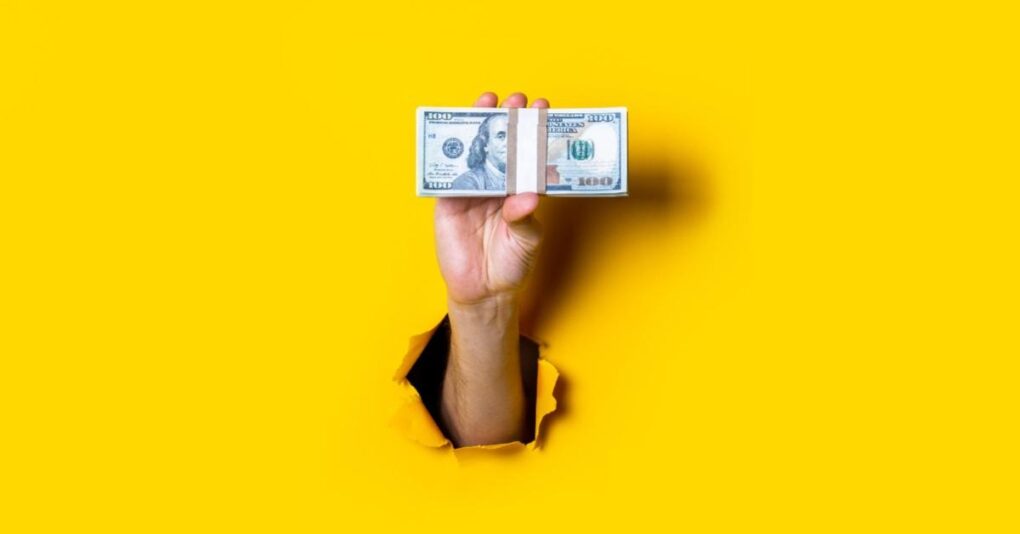
You might truly wonder: How can a bank, like the neighborhood bank down the street, “produce cash out of thin air”?
To answer that question, we should get in the wonderful kingdom of “fractional-reserve banking,” where deposits are become loans, loans are turned into money, and so on. For every old dollar that enters, 9 new dollars come out, created with the stroke of a pen or the click of a mouse. As you might be aware, basic deposits are loans by the bank depositor to the bank. Nevertheless, banks can spin new loans out of old loans, creating a wheel of fortune by providing the very same dollar to nine different customers– a feat that, to the uninitiated, is similarly rather incredible and frightening!
This monetary alchemy is completely legal and is in reality performed with the help and support of central banks all over, including our own Federal Reserve. If this wheel of fortune must strike a bump in the roadway and all of a sudden fall off its axle, triggering the bank to crash, don’t worry since a central bank can do what nobody else can lawfully do: fake new money to set things right, a feat that “all the king’s horses and all the king’s males” can refrain from doing!
Let’s take a more detailed take a look at how fractional-reserve banking works. Customer A deposits $10,000 in a bank account initially Bank. First Bank tapes the cash in its books and credits customer A’s account. The money is a property of the bank (a credit), which is offset by the liability to client A (a debit). First Bank now has cash to provide, based on federal government reserve requirements. Reserve requirements, which are developed by the Fed, specify the quantity (revealed as a percentage of deposits) that a lending institution need to keep in reserve, either as vault money or on deposit with a Federal Reserve bank, in order to guarantee payment of consumers’ deposits. The reserve requirement for “reservable” deposits greater than $36.1 million (since January 3, 2023) at any lending institution has been typically 10 percent. As a result, First Bank is totally free to provide $9,000 of the transferred money, keeping $1,000 in reserve.
Consumer B comes into First Bank seeking a vehicle loan. First Bank agrees to lend consumer B $9,000. First Bank credits client B’s checking account for $9,000 and debits a possession account called “loans receivable.” As you will recall, bank loans to clients are “investments” and, for that reason, are assets– not liabilities.
At the completion of these 2 transactions, First Bank’s declaration of financial condition would look like this (for simplicity, I have actually assumed no other deals).
Table 1: Declaration of monetary condition of First Bank, December 31, 2022
|
Properties |
(Credits) |
Liabilities and equity (Debits) |
|
Cash |
$10,000 |
Loans receivable$ |
|
9,000 Deposit liabilities$19,000 Reserves |
$ |
|
|
1,000 Bank equity$1,000 Totals$ |
20,000 |
$20,000 |
|
Notification that the bank |
has deposit |
liabilities |
|
of$19,000 and money on hand of $ |
10,000 |
|
|
. Let’s |
presume that the loan to customer B is |
for 3 years, payable with interest in month-to-month installations. The demand deposits( examining account balances)consist of the initial deposit of $10,000 from consumer A plus the profits of the loan to customer B of$9,000. Most likely, client B will invest the loan cash on a cars and truck in the next couple of days. Where did the loan money credited to customer B’s checking account originated from? Out of thin air! The wheel turns again when the car dealership transfers the $9,000 earnings in his bank, Second Bank. Now Second Bank, like First Bank, is free to make loans, subject to the 10 percent reserve
requirement. When the wheel finally stops turning, loans of$90,000 have actually been developed on a money base of simply $10,000. As we have actually seen, that cash is itself a chimera– nothing more than debt covered inside more debt. Table 2: Fractional-reserve banking Bank Deposits Reserves(10 percent)Loans Initially $10,000$1,000 $9,000 2nd $9,000$ 900$8,100 Third$ 8,100$810 $ 7,290 4th$7,290 $729 $6,561 Fifth$6,561 $656$5,905 Staying banks$59,049 $5,905$53,144 Overalls$100,000$10,000
|
$90,000 The table above demonstrates |
that banks can expand the cash supply by a factor of 10 |
||||
|
when the reserve |
requirement |
is 10 percent. Historically, the |
|||
|
United |
States |
reserve requirement has been 10 percent on transaction deposits, |
such as |
checking |
and negotiable order of |
|
withdrawal |
accounts(M1)deposits, and 0 percent on time deposits, such as deposits into cost savings accounts and certificates of deposit |
. The |
0 percent reserve requirement on time deposits enables banks to |
expand the money supply by more |
than an element |
|
of ten. |
Some would argue that banks are not really |
“insolvent, |
“simply sometimes illiquid– not always having all set money when needed. However, that’s true only if we consider simply one or a few banks at a time. Any bank having a short-term scarcity of money could constantly borrow the required funds to make up for the short-lived money shortage. The problem, however, is that all banks are illiquid and, when pricked by some basic financial shock, can easily slip into insolvency. When the reserve ratio is 10 percent, overall deposits are lowered by ten dollars for every dollar withdrawn from the banking system. Banks then have to hire loans or
sell securities to cover their depositor’s needs for money. This “liquidity crisis”is the factor behind a lot of monetary” panics, “bank runs, and comparable economic disturbances. It’s “financial obligation en route down,”but this time on a grand scale! Reliable March 26, 2020, the Federal Reserve reduced bank reserve requirements, get this, to no! Even prior to this modification, reserve requirements just used to transaction accounts, nonpersonal time deposits, and Eurocurrency liabilities.
Whatever else was “jokers are wild.”Hence, banks might produce as much counterfeit currency as the traffic would bear. When reserve requirements are no, the capability to develop cash is unlimited! The Fed’s cash adjustment is the origin of our economic issues. Bubbles in real estate prices, United States Treasury notes and bonds, and cryptocurrencies– to offer however a few examples– and the recent failures of the Silicon Valley, Republic, and Signature banks can all be traced to our financial policies. The essential concern for the majority of banks is that they are forced to invest “long”but borrow”brief,”something no sensible finance manager would ever do. Checking and other demand deposits are short-term liabilities of the bank. Bank loans, such as vehicle loan, are intermediate-term investments. Mortgage are long-term investments. Banks also buy government securities to stabilize their financial investment loan portfolio. Investing” long, “nevertheless, topics the bank to interest-rate dangers
due to the fact that the value of their financial investment loan portfolio is inversely associated to changes in interest rates. A thirty-year home loan yielding 2 percent is only worth a portion of a similar loan yielding 6 percent. To be more precise, a$100,000 financial investment in such an instrument would be worth just $44,280 if rate of interest
were to increase to 6 percent. If rate of interest rise to 8 percent, the value would fall to$31,768, according to the bond rate calculator. Therein lies the trap that Silicon Valley Bank(SVB )fell under– with disastrous outcomes. It’s the trap set by the very nature of fractional-reserve banking: Over a duration of simply 2 days in March 2023, the bank went from solvent to broke as depositors rushed to SVB to withdraw their funds, resulting in federal regulators closing the bank for excellent on March 10, 2023. SVB’s collapse marked the second biggest bank failure in U.S. history after Washington Mutual’s in 2008. That money created out of thin air should one day vaporize prior to our eyes must shock nobody, other than possibly Paul Krugman and his fellow court jesters at the New york city Times. The unlimited cycles of boom and bust are a direct outcome of federal government manipulation of the money supply. It’s actually that extensive and that simple.

